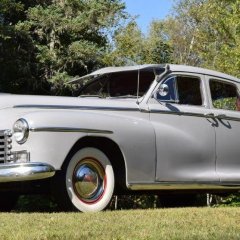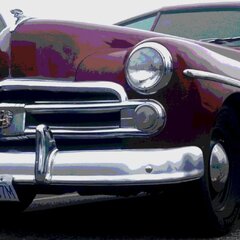All Activity
- Past hour
-
I’m trying to find some touch up paint for my original 1953 FARGO. I believe they used the same colors as dodge. Color is dark blue. Does anyone know of a supplier who knows the dodge/fargo colors and can provide paint.
-
I thought I’d chime in to share my success (thankfully) story. I could shift between 1st and Reverse, to 2nd if I was lucky, and to 3rd was ok. Going back to 2nd from 3rd was hit or miss. After reading the posts in this thread, I took the cable off. It was stuck and required a lot of pressure on either end to make it move. I hung it up vertically in my garage and sprayed penetrating oil and brake cleaner on each button and the 'collar' that houses each button. I let that soak a bit - then would press each side back and forth a few times. I'd then flip the cable around and spray the other button/collar to let liquid seep into the opposite end. After about 2 days of doing this on and off a handful of times per day, everything loosed up nicely. I can now make the cable move with very little pressure and it springs back into place without issue. I reinstalled the cable and we're back to normal. Thanks to everyone who posted!
-
As Paul Harvey would comment, and now the rest of the story....."90% of all ford pickups are still on the road today", the other 10% made it back home.
-
SteveR started following The Worst Parts Ever? and not for the guy who
-
Not mine! She is wonderful, helps me get my tools and assists me when needed. My wife is the reason I bought our 37 Plymouth.
-
In 1978 I was going to replace my 65 Barracuda. It was turning into a rust bucket in Minnesota. The front fenders were only held on by stubborn rust. I wanted a pickup, but which one? I listened to all the hype and had a brother-in-law who worked for Ford Motor Company. He assured me it was a good choice Coupled that with, "Built Ford tough" slogan and "90% of all ford pickups are still on the road today", I bought an F150, 6 cylinders, 4 speed with overdrive. It had a 12,000 mile warranty. I had problems from 3000 miles with the transmission. The service backup was, well, pathetic. My dog could do a better job than they did. At 12,164 Miles at night I was on the last leg of a 300-mile trip home when the left front wheel bearing disintegrated at 70mph. Prior to this I had 3 seals replaced in the rear end. I finally replaced the transmission with a manual 3 speed. That truck was the biggest piece of junk I have ever owned. So what part was bad? The whole damn thing!
- Today
-
Finally got the ol' Dodge buttoned up after all the winter work I did on it. I was kind of anxious, as this was the first start after completely rebuilding the carburetor and reinstalling the Sisson choke. And, it started right up once fuel got into the bowl. I have some adjustments to make to get it to warm-up a bit smoother, I am not used to dealing with the Sisson choke and a working fast idle, but it was cool watching the Sisson choke arm relax as the car warmed up. I had my doubts the choke would work, I removed it over 30 years ago because it wasn't working right, but since found out why (thanks to this Forum and Rich Hartung's information) and finally decided to remedy it. Simple enough, it wasn't adjusted right, and it never had the gasket. The bimetal arm is a tad rusty, I thought that would affect it, but it doesn't look like it. Alas, no drive though. The fuel pump diaphragm gave up the ghost. Not enough to keep the car from running, but enough to clean off the side of the engine and start a gasoline puddle (Fuel squirting out from somewhere on the top of it). Annoying but not surprising, since it's a good 30 years old. Installed it when we lived in El Paso, TX after the EPA mandated an ethanol requirement in winter gas, but before anyone knew what ethanol does to older fuel systems - so not ethanol resistant. New one is on the way. "It's only April", so it snowed yesterday and last night, I wouldn't have taken it out anyway.
-
Not yet. But I see Permatex makes a fuel resistant gasket dressing/sealant, so I think I'll give that a try.
-
And unless you miraculously find the washer on the garage floor, anything you do will be better than running the car with that washer hiding in there somewhere. Maybe a small fridge magnet firmly attached to a wire so you can fish around better in the nooks and crannies?
-
Good idea, Tod, I tried that but was not successful thus far. I also loaned a borescope from the zone, but it is a bit too large to get into the cylinder and you cannot see anything with that little mirror adapter. I've got the cylinder to TDC, fishing in there with a small magnet but am not pulling anything out. I also undone the exhaust pipe below the manifold and was able to get up to the valve with the scope - nothing... Tried a vacuum cleaner, at various places, too. I am pretty sure that the intake was closed when this happened, the exhaust was open. So it's got to be in the exhaust... I'll just take the manifolds off, tomorrow, and check some more. It is better than removing the head, at this point 🥲
-
Ever seen water get pulled way up a leaking low slope roof ? Capillary attraction between layers of roofing. Could happen to a porous casting.
-
Pistons should be aluminum (non-magnetic) while the split lock washer should be steel (magnetic). You might be able to fish it out or verify it is not in the cylinder using one of those magnet on an extendable wand tools.
-
To me, that all looks fine. Perhaps your local gas pump is adding something to the gas, wouldnt surprise me one bit. The fuel isnt pouring out the side of the carb, so cleaning up the gasket surfaces to a smooth finish and make sure they are true. Use JB weld to body work the gasket surface if you have to. Also, use a fresh gasket..
-
Perhaps someone else can repeat the experiment on one of their carbs and report back. I don't have any carbs floating around or I'd try it myself.
-
Didn't try using sealant on the gasket, yet?
-

How Many Pilot House Trucks Have Survived?
JBNeal replied to Bradley S.'s topic in Mopar Flathead Truck Forum
SURVIVOR: saw this Dodge between Lake Graham and Newcastle -
Well, I admin - I've done some pretty unintelligent garage stuff, before, but today was probably the absolute bottom record. That likely even beats catching the oil filter on fire... I needed to turn the engine by hand, so I took out the plugs. Then I decided to use the starter (to check for oil pressure) so I disconnected the - wire from the ignition coil and (dropped the little split washer right into the #6 cylinder... Oooops... Cannot get it out because I don't see it. Chances are, it went straight into an open exhaust or intake valve 🙄
-
That's reasonable, it will be interesting how much you would charge for your own time and effort 😋
-
Are you suggesting I need to wash the washer/dryer in the garage??? ..... Blasphemy!
-
Back to the gas issue. After I started and ran the engine for a few minutes, I saw some gas pooling in the now usual places around the airhorn gasket and adjoining surfaces, as expected. I also saw some wetness down below on the gasket between the carb body and the lower spacer plate. At that point I figured I'd just take the damn carb off and have a look at in on the bench. Gradually I took the carb apart (airhorn, spacer plate, throttle plate) while looking for anything obvious. Didn't notice anything. So I'm left with the float bowl in my hand, which still has gas in it. Removed the float, accelerator pump and the jet/needle assembly thing and set the bowl on the bench. The top gasket surface of the float bowl is still wet so I wipe it off repeatedly. And repeatedly it becomes wet again. Then I dumped the gas out of the float bowl and dried it out with compressed air. The inside walls of the float bowl look kind of rough in my opinion, and seem to have a fair amount of pits and voids (see photos). Granted, I know the surface isn't supposed to be precision smooth, but they look rougher than I expected. Then I took some fresh gas and poured about 1/2" of it into the bowl and watched. You'll notice in the photos how dry and almost chalky the float bowl looks. Well, as I'm watching it, I see the gas wicking it's way up the walls of the float bowl. Not fast, but it's happening. There is a distinct "wetness line" creeping its way up the walls. Eventually I see gas pooling again on the top gasket surface. So by everything I've seen, I have to conclude that the casting is porous. Maybe it was ok when it was made, but over time deteriorated? I don't know. I think it's new carb time.
-
As others have said, the Dodge/Chrysler/Plymouth/DeSoto flathead sixes have hardened exhaust valve seats from the factory, and they are very capable of handling modern, unleaded gas without any issue. They came that way starting in 1933 or 1934, and remained that way throughout all years that they were produced, which was well into the 1970's. So you don't need to worry about that.
-
It's interesting how the rules change so much. We pay typically about .75 more than the regular but the no ethanol is only available in premium.
-
Moparpro is a great place to way overspend on parts. There is nothing special about him.
-
What is your altitude? The acceptable vacuum value drops as you go higher in altitude.
-
Well, in that case I will put together a kit and charge even more for it, I'll include bulbs, lol.















